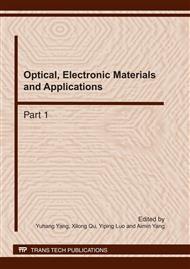[1]
G. Zhu, J. Dai, S. Zhang, Generation mechanism and distribution and characteristics of hydrogen sulfide bearing gas in China, Natural Gas Geoscience 15 (2004) 166-170. in Chinese.
Google Scholar
[2]
Z. Y. Liu, C. F. Dong, X. G. Li, Q. Zhi, Y. F. Cheng: J Mater Sci Vol. 44 (2009), p.4228.
Google Scholar
[3]
H. D. Deng, C. F. Li, X. L. Cao, C. J. Pan: Int. Rev. Chem. Eng. Vol. 2(2010), p.75.
Google Scholar
[4]
C. D. Waard, D. E. Milliams: Corrosion Vol. 31 (1975), p.177.
Google Scholar
[5]
Nesic S., Postlethwaite J., Olsen S: Corros. Vol. 52 (1996), p.280.
Google Scholar
[6]
Bolmer P. W.: Corros. Vol. 21 (1965), p.69.
Google Scholar
[7]
S. P. Ewing: Corros. Vol. 11(1955), p.51.
Google Scholar
[8]
Schmitt G, Fundamental aspects of CO2 corrosion of steel, CORROSION/l983, paper no. 44, Houston: MACE, (1983).
Google Scholar
[9]
Kermani M. B., Morshed A.: Corros. Vol. 59 (2003), p.659.
Google Scholar
[10]
Ramanarayanan T. A., Smith S. N: Corros. Vol. 46 (1996), p.66.
Google Scholar
[11]
Smith J. S., Miller J. D. A.: J. Brit. Corros. Vo. 10 (1975), p.136.
Google Scholar
[12]
Sardisco J.B., Pitts R. E.: Corros. Vol. 21 (1965), p.350.
Google Scholar
[13]
Huang H., Shaw W. J. D.: Corros. Vol. 48 (1992), p.931.
Google Scholar
[14]
Wei Baoming: Corrosion theory of metal and its application (Chemical Industry Press, China, 1984).
Google Scholar
[15]
V. C. Wagner, W. Traud, Z: Electrochem., Vol. 44 (1938), p.391.
Google Scholar
[16]
Gao Ying, Wu Bing: The foundation of electrochemisty (Chemical Industry Press, China, 2004).
Google Scholar
[17]
Th. Wandlowski, D. Lampner, S.M. Lindsay: J. Electroanal. Chem. Vol. 404(1996), p.215.
Google Scholar
[18]
S. Pronkin, Th. Wandlowski: J. Electroanal. Chem. Vol. 550–551 (2003), p.131.
Google Scholar
[19]
M. Hara, U. Linke, Th. Wandlowski: Electrochimica Acta Vol. 52 (2007), p.5733.
Google Scholar
[20]
Parkins R. N. The involvement of Hydrogen in Low pH stress corrosion cracking of pipeline steel, 12th EPRG/PRCI Biennial Joint Technical Meeting in Line Pipe Research, May, Croningen, the Netherlands, (1999).
Google Scholar
[21]
Gray L. G. S., B. G. Andersion, M. J. Danysh, P. G. Tremaine, Effect of pH and temperature on the mechanism of carbon steel corrosion by aqueous carbon dioxide., CORROSION/90, paper no. 40, Houston, TX: NACE, (1990).
Google Scholar
[22]
J. O. M. Bockris, J. McBreen, L. Nanis, J. Electrochem. Soc. Vol. 112 (1965), p.1025.
Google Scholar


